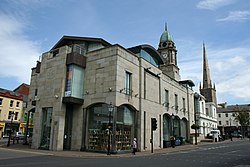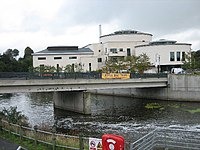Difference between revisions of "Lisburn"
(Created page with '{{Infobox town | name=Lisburn | county=County Antrim | picture=Irish Linen Centre Lisburn Museum.jpg | picture caption=Irish Linen Museum and Christ Church Cathedral | latitude=5…') |
|||
| (2 intermediate revisions by 2 users not shown) | |||
| Line 12: | Line 12: | ||
| postcode=BT27, BT28 | | postcode=BT27, BT28 | ||
| dialling code=028 | | dialling code=028 | ||
| − | | LG district=Lisburn | + | | LG district=Lisburn |
| constituency=Lagan Valley | | constituency=Lagan Valley | ||
}} | }} | ||
| + | '''Lisburn''' is a city of [[County Antrim]], standing south-west of [[Belfast]] on the [[River Lagan]], which forms the boundary between the counties of [[County Antrim|Antrim]] and [[County Down|Down]]. Lisburn is [[Northern Ireland]]'s third-largest city, and received its city status in 2002 as part of Queen Elizabeth II's Golden Jubilee celebrations. | ||
| − | + | ==Name== | |
| − | + | ||
| − | ==Name == | + | |
| − | + | ||
The city was originally known as ''Lisnagarvey'', said to come from the Gaelic ''Lios na gCearrbhach'', or "fort of the gamblers". Cathedral records suggest that the name ''Lisburn'' came into common use around 1662. | The city was originally known as ''Lisnagarvey'', said to come from the Gaelic ''Lios na gCearrbhach'', or "fort of the gamblers". Cathedral records suggest that the name ''Lisburn'' came into common use around 1662. | ||
| − | The headquarters of the | + | The headquarters of the British Army in Northern Ireland at Thiepval Barracks and the headquarters of the Northern Ireland Fire Brigade are located in the city. |
==History == | ==History == | ||
| − | Lisburn's original site was located on what is now known as Hill Street, on a hill above the [[River Lagan]]. Its origin was in 1611 when | + | Lisburn's original site was located on what is now known as Hill Street, on a hill above the [[River Lagan]]. Its origin was in 1611 when King James I granted Sir Fulke Conway the lands of Killultagh in south western Antrim. Lisburn's original streets were laid out during the 1620s; Market Square, Bridge Street, Castle Street and Bow Street. Sir Fulke built a manor house on what is now Castle Gardens and brought many settlers from England and Wales. In 1623 he built a church on the site of the current cathedral. The Manor House was destroyed in the accidental fire of 1707 and was never rebuilt. |
[[File:Lisburn Market House.JPG|thumb|right|250px|Lisburn Market House]] | [[File:Lisburn Market House.JPG|thumb|right|250px|Lisburn Market House]] | ||
| Line 33: | Line 31: | ||
Lisburn is also known as the birthplace of Ireland's linen industry, which was established in 1698 by Louis Crommelin and other Huguenots. An exhibition about the Irish linen industry is now housed in the Irish Linen Centre, which can be found in the town’s old Market House in Market Square.<ref>[http://www.lisburncity.gov.uk/irish-linen-centre-and-lisburn-museum/ Lisburn City Council: Irish Linen Centre and Lisburn Museum]</ref> | Lisburn is also known as the birthplace of Ireland's linen industry, which was established in 1698 by Louis Crommelin and other Huguenots. An exhibition about the Irish linen industry is now housed in the Irish Linen Centre, which can be found in the town’s old Market House in Market Square.<ref>[http://www.lisburncity.gov.uk/irish-linen-centre-and-lisburn-museum/ Lisburn City Council: Irish Linen Centre and Lisburn Museum]</ref> | ||
| − | Between 1954 and 1992 Lisburn contained the operational headquarters of No 31 Belfast Group Royal Observer Corps<ref>[http://www.subbrit.org.uk/rsg/roc/group_hq.html ROC HQ locations and photographs]</ref> who operated from a protected nuclear bunker on Knox Road within Thiepval Barracks. Converted from a 1940s Anti-aircraft Operations Room (AAOR) the bunker would support over one hundred ROC volunteers and a ten man United Kingdom Warning and Monitoring Organisation warning team responsible for the famous "four-minute warning" in the event of a nuclear strike on the United Kingdom. The ROC would also have detected radioactive fallout from the nuclear bursts and warned the public of approaching fallout. Thankfully it was never called upon so to act. The two organisations were stood down in 1992 at the end of the Cold War. | + | Between 1954 and 1992 Lisburn contained the operational headquarters of No 31 Belfast Group Royal Observer Corps<ref>[http://www.subbrit.org.uk/rsg/roc/group_hq.html ROC HQ locations and photographs]</ref> who operated from a protected nuclear bunker on Knox Road within Thiepval Barracks. Converted from a 1940s Anti-aircraft Operations Room (AAOR) the bunker would support over one hundred ROC volunteers and a ten-man United Kingdom Warning and Monitoring Organisation warning team responsible for the famous "four-minute warning" in the event of a nuclear strike on the United Kingdom. The ROC would also have detected radioactive fallout from the nuclear bursts and warned the public of approaching fallout. Thankfully it was never called upon so to act. The two organisations were stood down in 1992 at the end of the Cold War. |
[[File:The Island Civic Centre - geograph.org.uk - 64602.jpg|thumb|right|200px|Lisburn Civic Centre]] | [[File:The Island Civic Centre - geograph.org.uk - 64602.jpg|thumb|right|200px|Lisburn Civic Centre]] | ||
| − | |||
| − | |||
| − | |||
==Churches== | ==Churches== | ||
| − | |||
Lisburn is notable for its large number of churches; in the wider Lisburn City area, 134 churches are listed.<ref>http://www.lisburn.com/churches/Lisburn-churches/churches-list.htm</ref> | Lisburn is notable for its large number of churches; in the wider Lisburn City area, 134 churches are listed.<ref>http://www.lisburn.com/churches/Lisburn-churches/churches-list.htm</ref> | ||
| Line 53: | Line 47: | ||
*[http://www.lisburncricketclub.co.uk/ Lisburn Cricket Club] | *[http://www.lisburncricketclub.co.uk/ Lisburn Cricket Club] | ||
*[http://www.bfbs.com/lisburn BFBS Radio Lisburn] | *[http://www.bfbs.com/lisburn BFBS Radio Lisburn] | ||
| + | {{Cities in the United Kingdom}} | ||
Latest revision as of 12:37, 30 March 2016
| Lisburn | |
| County Antrim | |
|---|---|
 Irish Linen Museum and Christ Church Cathedral | |
| Location | |
| Location: | 54°30’43"N, 6°1’52"W |
| Data | |
| Population: | 71,465 (2001) |
| Post town: | Lisburn |
| Postcode: | BT27, BT28 |
| Dialling code: | 028 |
| Local Government | |
| Council: | Lisburn and Castlereagh |
| Parliamentary constituency: |
Lagan Valley |
Lisburn is a city of County Antrim, standing south-west of Belfast on the River Lagan, which forms the boundary between the counties of Antrim and Down. Lisburn is Northern Ireland's third-largest city, and received its city status in 2002 as part of Queen Elizabeth II's Golden Jubilee celebrations.
Contents
Name
The city was originally known as Lisnagarvey, said to come from the Gaelic Lios na gCearrbhach, or "fort of the gamblers". Cathedral records suggest that the name Lisburn came into common use around 1662.
The headquarters of the British Army in Northern Ireland at Thiepval Barracks and the headquarters of the Northern Ireland Fire Brigade are located in the city.
History
Lisburn's original site was located on what is now known as Hill Street, on a hill above the River Lagan. Its origin was in 1611 when King James I granted Sir Fulke Conway the lands of Killultagh in south western Antrim. Lisburn's original streets were laid out during the 1620s; Market Square, Bridge Street, Castle Street and Bow Street. Sir Fulke built a manor house on what is now Castle Gardens and brought many settlers from England and Wales. In 1623 he built a church on the site of the current cathedral. The Manor House was destroyed in the accidental fire of 1707 and was never rebuilt.
Negotiations preceding the American War of Independence between Ben Franklin and Lord Hillsborough took place at Hillsborough near the town.
Lisburn is also known as the birthplace of Ireland's linen industry, which was established in 1698 by Louis Crommelin and other Huguenots. An exhibition about the Irish linen industry is now housed in the Irish Linen Centre, which can be found in the town’s old Market House in Market Square.[1]
Between 1954 and 1992 Lisburn contained the operational headquarters of No 31 Belfast Group Royal Observer Corps[2] who operated from a protected nuclear bunker on Knox Road within Thiepval Barracks. Converted from a 1940s Anti-aircraft Operations Room (AAOR) the bunker would support over one hundred ROC volunteers and a ten-man United Kingdom Warning and Monitoring Organisation warning team responsible for the famous "four-minute warning" in the event of a nuclear strike on the United Kingdom. The ROC would also have detected radioactive fallout from the nuclear bursts and warned the public of approaching fallout. Thankfully it was never called upon so to act. The two organisations were stood down in 1992 at the end of the Cold War.
Churches
Lisburn is notable for its large number of churches; in the wider Lisburn City area, 134 churches are listed.[3]
The Church of Ireland's Diocese of Connor has one of its two cathedral's in Lisburn: Christ Church Cathedral.
References
Outside links
| Cities in the United Kingdom |
|---|
|
Aberdeen • Armagh • Bangor (Caernarfonshire) • Bangor (County Down) • Bath • Belfast • Birmingham • Bradford • Brighton and Hove • Bristol • Cambridge • Canterbury • Cardiff • Carlisle • Chelmsford • Chester • Chichester • Colchester • Coventry • Derby • Doncaster • Dundee • Dunfermline • Durham • Ely • Edinburgh • Exeter • Glasgow • Gloucester • Hereford • Inverness • Kingston upon Hull • Lancaster • Leeds • Leicester • Lichfield • Lincoln • Lisburn • Liverpool • City of London • Londonderry • Manchester • Milton Keynes • Newcastle upon Tyne • Newport • Newry • Norwich • Nottingham • Oxford • Perth • Peterborough • Plymouth • Portsmouth • Preston • Ripon • Rochester • Salford • Salisbury • Sheffield • Southampton • St Albans • St Asaph • St David's • Southend-on-Sea • Stirling • Stoke-on-Trent • Sunderland • Swansea • Truro • Wakefield • Wells • Westminster • Winchester • Wolverhampton • Worcester • Wrexham • York |

